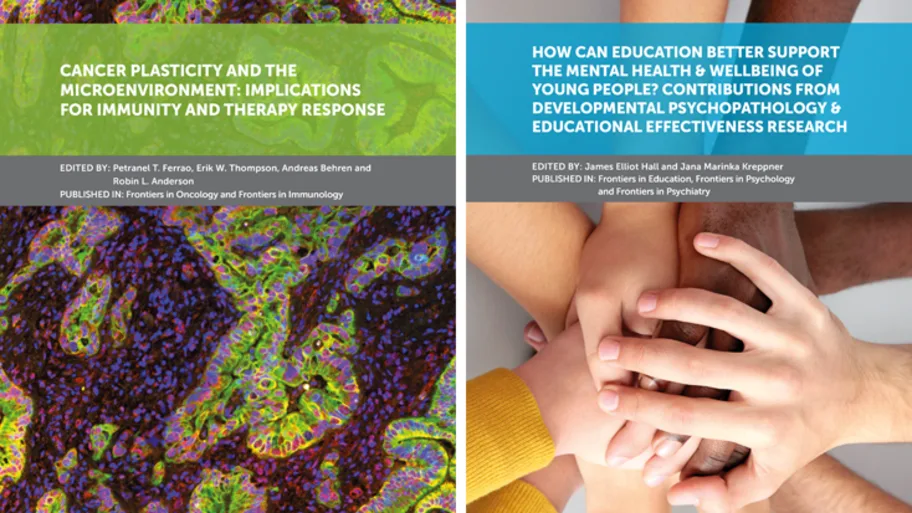
- Science News
- Featured news
- Kelly Thompson – Bringing sex and gender differences to the forefront
Kelly Thompson – Bringing sex and gender differences to the forefront
Dr Kelly Thompson is the Director of Research Operations at the Nepean Blue Mountains Local Health District in Western Sydney and an active researcher at The George Institute for Global Health. Having led the Global Women’s Health program at The George Institute as Program Manager, Kelly has more than five years of experience overseeing research on the health of women across the lifespan. Her personal research looks at critical infections and sepsis through an epidemiological lens with a focus on health equity and women’s health. Kelly and I discuss the role of reporting on sex and gender differences in disease, the importance of language when talking about these differences, and what is needed to achieve the United Nations Sustainable Development Goal 5.
Kelly is currently serving as Associate Editor for Frontiers in Global Women’s Health.

Photo credit: The George Institute for Global Health
What made you want to pursue public health research, particularly focusing on health equity?
“I started in clinical nursing in intensive care and loved it. Clinical nursing felt like a bit of a calling to me because of the focus on helping people, though eventually I wanted to have an impact on a larger scale. Fundamentally, I’ve always felt deeply uncomfortable with social injustice. Pursuing public health was an opportunity for me to reconcile things that I’ve often contemplated in my life, particularly with regard to social inequalities in Australia. I grew up in a rural area and witnessing the treatment of our First Nations people, I am aware of the inequalities and prejudices that exist.
“Later, I became fascinated with big data and what can be done with the routinely collected data that gets captured in a hospital. There are millions and millions of patient records that can provide insights on social determinants of health. I am really interested in this data and how it can be used to influence policy.”
Recently, you’ve taken on a new role as Director of Research Operations at the Nepean Blue Mountains Local Health District. What made you want to make the transition from a primarily research-focused role to being more hands on in the health system?
“Once I had decided I wanted to pursue public health, I went off and had ten fabulous years at The George Institute and I continue to be involved in research with the Global Women’s Health program.
“After I finished my PhD, I moved out of the center of Sydney to the Blue Mountains. The area is a World Heritage National Park and so beautiful. We bought a house and were living the dream, but I just felt so disconnected from the community. I felt there was an opportunity for me to leverage my research experience and bring it back home.
“It’s also true that there is a huge disconnect between academic research and what happens on the ground. A lot of the things we write and talk about in academia just don’t penetrate into the health system and it’s a real problem. That’s why I wanted to be closer to the grassroots of health.”
You’ve helped establish the Global Women’s Health program at The George Institute. Can you elaborate a little bit on what the program focuses on?
“My colleagues and I worked closely with Professor Robyn Norton, who was really the driving force behind the establishment of the Global Women’s Health program. In health research, particularly in global health, women’s health is often seen through the lens of sexual reproductive and maternal health. However, we have seen a distinct change in the burden of disease for women. Pregnancy complications and birth complications have decreased with the availability of antibiotics and a generally higher standard of healthcare. Now, we see the burden of disease is shifting towards non-communicable diseases; heart disease, stroke, and dementia being the leading causes of death worldwide. We strongly felt that there was not enough emphasis on this shift and so the Global Women’s Health program was established to address that gap.
“There are two key themes in the program:
The integration and management of pregnancy, specifically with regard to the prevention of non-communicable diseases that may follow high-risk pregnancies. It’s about utilizing the opportunity that pregnancy presents — women are already seeing the health system for care, so it’s important to focus on both women and child, not just the child.
The sex and gender disaggregation of health data. Traditionally, research methods have been based on the men’s model of health. In the very early days, women weren’t even included in studies, but results were generalized and assumed to be applicable for all. We now know this to not be the case, but it’s a realization that is still evolving. So the second focus of the program is to better understand sex and gender differences.”
In mid-2020, you co-authored an article in Frontiers in Global Women’s Health. At the time, there were some early findings suggesting that men infected with COVID-19 may be more likely to experience severe disease than women. You and your co-authors argued that with the available data it was truly very difficult to actually quantify sex differences and that drawing premature conclusions could cause harm. As you already mentioned, the lack of data on sex and gender differences in disease is still a pervasive issue in health research. From your experience working in the field, why do you think that is?
“A lot of it has to do with the lack of emphasis on such data. Researchers are not necessarily looking at sex differences on a regular basis and the majority of that kind of research is done externally by people such as myself and others who are interested in this field. There are almost always sex differences when we examine new conditions which emphasizes the need to look at such data routinely.
“Another reason is, as mentioned before, the fact that research is historically a male dominated domain. With regard to research participants, women were often excluded from studies. In the case of COVID-19, pregnant women were excluded from research. Understandably this can be primarily due to safety concerns, but it’s important to recognize that there are implications to not having that data.
“Furthermore, we need to consider that the people who have conducted research historically have been men. Looking at senior and first authors on papers and journal editorial boards, it’s evident that we still lack diversity. Representation is really vital when it comes to embedding sex and gender considerations in health research.”
From an editorial perspective, what do you think is the role of academic journals in helping ensure research considers sex and gender differences?
“There is no one size fits all approach to fixing these issues, but I do believe that we need champions who will drive change in many places.
“For example, there are the International Committee of Medical Journal Editors (ICMJE) guidelines on preparing a manuscript. These guidelines discuss the need to look at important variables, such as age and sex, as well as the need to clearly define sex and gender variables used. They encourage authors to consider sex and gender differences and ask them to state why they are not reporting on these differences, if they aren’t. So it’s not a lack of guidance. We have accepted policies, but there is a gap in implementation. There are several reasons for this gap.
“For one, a lot of medical research is conducted by clinical academics who do it on the side of clinical work. Sex and gender considerations are an additional step which adds to the workload. I think that journals also have a responsibility to ensure authors do consider these differences, for example, by educating reviewers and establishing diverse voices on the editorial boards.
“Another point is defining a standard language to be used for reporting sex and gender. This would require agreement from a large number of stakeholders with varying perspectives, so it would be a very challenging thing to achieve. However, gaining some consensus and consistency with naming and classifying things would be helpful.
“A few years ago, we published a letter in response to the Lancet’s women series discussing the possibility for journals to include sex and gender guidance on their submission pages. If we had big journals asking researchers to ensure they consider certain questions, it would help bring the topic to the forefront.”
You briefly mentioned language. Last year you published another letter in response to Dr. Sophia Davis’ “Periods on display,” a review of the “Periods: A Brief History” exhibition in London, which some felt was controversial for its use of gender-neutral language. From your point of view, what do you think is the role of inclusive language in health research?
“There is a role for inclusive language, but I don’t think we have found that language yet. There are so many different stakeholders in this and I think it will take a while to unpack and come to a consensus.
“One of the reasons that the “Periods on display” piece was perceived as so controversial was due to the way it was presented when it was first disseminated. I don’t think this represented the context of what was written in the article. So I see a responsibility for journals to consider their role in the representation and use of this kind of language.
“While I believe that everyone should be able to have their voice heard, we also need to acknowledge the evolving nature of our understanding of sex and gender.
“Overall, it’s important for the debate around different perspectives on the use of language in sex and gender issues not to overshadow all other aspects of the conversation. The “Periods on display” piece reviewed an exhibition at the London Museum of Vaginas which covered important topics like period poverty. There needs to be room for us to hear those voices too.”
The United Nations Sustainable Development Goal 5 focuses on achieving gender equality and empowering all women and girls. The COVID-19 pandemic has highlighted and, in some cases, exacerbated many challenges in the field of women’s health. What do you think is needed now if we want to achieve gender equity in health?
“I think diversity in leadership is key. Women need to have a seat at the table and not just in executive roles, but also at board level and other influential positions. Women from all different kinds of backgrounds need to be able to take up roles that allow them to make use of their talents and abilities. There is so much value to be gained from including diverse perspectives, particularly when speaking about global health.
“We also need to start speaking openly and honestly about the societal challenges women face and to think about the root causes of these problems. Generally, I feel that we are leaving it until too late. These conversations need to be embedded into our education systems in order to bring change at really fundamental levels.
“Finally, going back to our changing understanding of sex and gender, I do think that it’s important to acknowledge diversity moving forward. Sustainable Development Goal 5 focuses on women and girls, but I think we are moving in a direction where we will also need to consider other gender-diverse people. It will be important to be open to listening and valuing the perspectives of others who might have had experiences which are different from our own.”

Frontiers is a signatory of the United Nations Publishers COMPACT. This interview has been published in support of United Nations Sustainable Goal 5: Achieve gender equality and empower all women and girls.






